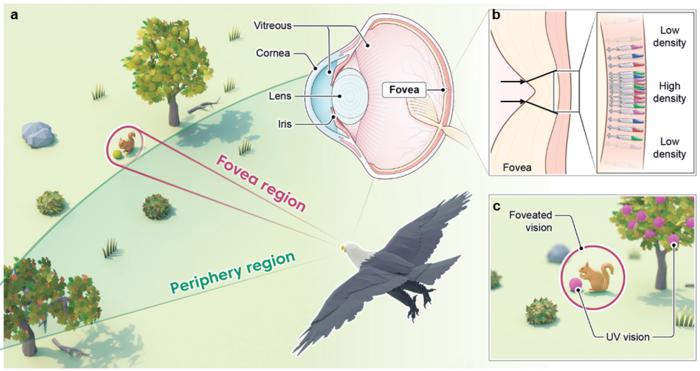Researchers from the Institute for Basic Science (IBS) and the Gwangju Institute of Science and Technology (GIST) have developed a new type of camera that draws inspiration from the unique structures and functions of bird eyes. The perovskite-based camera, designed to specialize in object detection, incorporates an artificial fovea and a multispectral image sensor that responds to both ultraviolet (UV) and visible light (red, green, blue; RGB).
The eyes of raptors, such as eagles, have evolved over countless years to adapt to their high-altitude habitat and the need to accurately perceive prey from kilometers away. These bird eyes feature deep central foveae, which refract incoming light to a greater extent than the shallow foveae found in human eyes. The region of highest cone density lies within the foveae, enabling birds to magnify and clearly perceive distant objects through foveated vision. Additionally, bird eyes possess four cones that respond to UV and RGB light, providing them with tetrachromatic vision and the ability to acquire abundant visual information for effective target object detection in dynamic environments.
Mimicking Nature’s Design: Artificial Fovea and Multispectral Image Sensor
Inspired by these avian visual capabilities, the IBS research team designed their camera to incorporate an artificial fovea that mimics the deep central foveae found in bird eyes. Through optical simulation, they optimized the design to allow the camera to magnify distant target objects without image distortion.
To create the multispectral image sensor, the researchers utilized perovskite, a material renowned for its excellent electrical and optical properties. They fabricated four types of photodetectors using different perovskite materials that absorb different wavelengths and vertically stacked them to form the final multispectral image sensor.
Dr. PARK Jinhong, the study’s first co-author, highlighted the team’s development of a new transfer process for vertically stacking the photodetectors. By employing a perovskite patterning method from their previous research, they successfully fabricated the multispectral image sensor capable of detecting UV and RGB without the need for additional color filters.
Enhanced Object Recognition and Motion Detection
Unlike conventional cameras that use zoom lenses to magnify objects, often focusing solely on the target object and not its surroundings, the bird-eye-inspired camera provides a magnified view of the foveal region along with the surrounding peripheral region. By comparing these two fields of vision, the new camera achieves greater motion detection capabilities than conventional cameras. Moreover, the camera’s ability to distinguish UV and RGB light without additional color filters makes it more cost-effective and lightweight.
The research team validated the object recognition and motion detection capabilities of their camera through simulations. The new camera demonstrated a confidence score of 0.76 for object recognition, nearly double that of existing camera systems (0.39). Additionally, the motion detection rate increased by 3.6 times compared to existing camera systems, indicating significantly enhanced sensitivity to motion.
Prof. Kim emphasized the potential applications of this camera technology, stating, “Birds’ eyes have evolved to quickly and accurately detect distant objects while in flight. Our camera can be used in areas that need to detect objects clearly, such as robots and autonomous vehicles. In particular, the camera has great potential for application to drones operating in environments similar to those in which birds live.”
This innovative camera technology represents a significant advancement in object detection, offering numerous potential applications across various industries. By drawing inspiration from nature’s design, researchers have developed a camera that could revolutionize the way we perceive and interact with the world around us.


